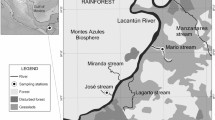Abstract
The distribution and abundance of subtidal meiofauna in Mandovi estuary of Goa were studied from June 1983 to June 1984. Monthly faunal abundance ranged from 491 to 2791/10 cm2 and dry weight biomass from 0.16 to 2.80 mg 10 cm2. Free living nematodes were the dominant group contributing over 75% of the total density and 30 to 42% of the total biomass. Among nematodes the deposit feeders were more abundant in fine muddy substratum while epigrowth feeders dominated in sandy substratum.
Harpacticoids were next, comprising 6.9 to 8.7% of the total meiofauna number, followed by turbellaria (3.8–4.5%), polychaeta (2.8–3.2%) and ostracods (1.6–4.5%) The contribution of other groups to faunal density was 4.5–6.2%. In the biomass the ostracods contributed most (29.8–54.7%), followed by nematodes (23.8–34.6%). Over 60% of the fauna occurred in the top 2 cm of the sediment and the faunal density reduced significantly with increasing depth in the sediment. The vertical distribution of meiofauna was positively correlated to the vertical distribution of Eh, chlorophyll a and interstitial water. Seasonality was greatly influenced by the south-west monsoon and the fauna quickly repopulated after the monsoon. Salinity, temperature and food influenced the faunal abundance.
Similar content being viewed by others
References
Alongi, D. M., 1987. Intertidal zonation and seasonality of meiobenthos in tropical mangrove estuaries. Mar. Biol. 95: 447–458.
Alongi, D. M., 1990. The ecology of tropical soft bottom benthic system. Oceanogr. Mar. Biol. Annu. Rev. 28: 381–496.
Anker, S. & R. Elmgren, 1976. The benthic macro and meiofauna of the landsort sea (Northern Baltic proper), a stratified random sampling survey. Contribution from the Asko laboratory, University of Stockholm 11: 1–115.
Ansari, Z. A., A. Chatterji & A. H. Parulekar, 1984. Effect of domestic sewage on sand beach meiofauna at Goa, India. Hydrobiologia 111: 229–233.
Azis, P. M. A. & N. B. Nair, 1983. Meiofauna of the Edava-Nadayara Paravur backwater system of south west coast of India. Mahasagar- Bull. Natn. Inst. Oceanogr. 16: 55–66.
Bouwman, L. A., K. Romeijn & W. Admiraal, 1984. On the ecology of meiofauna in an organically polluted estuarine mud flat. Estuar. coast. Shell. Sci. 19: 633–653.
Cantelmo, F. R., 1978. The ecology of sublittoral meiofauna in a shallow marine embayment. Ph.D. Thesis, University of New York, 137 pp.
Capstick, C. K., 1959. The distribution of free living nematodes in relation to salinity in the middle and upper reaches of River Blyth estuary. J. anim. Ecol. 28: 189–210.
Coull, B. C., 1973. Estuarine meiofauna: A review: Trophic relationship and microbial interaction. In H. Stevenson & R. R. Colwell (eds), Estuarine microbial ecology. University of South Carolina Press: 499–512.
Coull, B. C. & S. S. Bell, 1979. Perspective in marine meiofauna ecology. In R. J. Levington (ed.), Ecological processess in coastal and marine system. Plenum Publishing Corporation: 189–216.
Damodaran, R., 1973. Studies on the benthos of the mud bank of Kerala coast. Bull. Dept. Mar. Sci. University of Cochin, VI: 1–112.
Dye, A. H. & J. P. Furstenburg, 1978. An ecophysiological study of the meiofauna of the Swartkops estuary. The meiofauna: composition, distribution, seasonal fluctuation and biomass. Zool. Afr. 13: 19–32.
Dye, A. H. & J. P. Furstenburg, 1981. Estuarine meiofauna. In J. H. Day (ed.), Ecology of estuaries with particular reference to South Africa: 179–185.
Elliot, J. M., 1977. Some methods for the statistical analysis of samples of benthic invertebrates. Freshwater Biological Association Scientific Publication Number 25, 159 pp.
ElWakeel, S. K. & J. P. Riley, 1956. The determination of organic carbon in marine muds. J. Cons. perm. int. Explor. Mer., 22: 180–183.
Folk, R. L., 1968. Petrology of sedimentary rocks. Hemphills, Austin & R. M. S., Texas, 170 pp.
Heip, C., 1975. On the significance of aggregation in some benthic marine invertebrates. In H. Barnes (ed.), Proc 9th Europ mar. biol. Symp. Aberdeen University Press: 527–538.
Heip, C. & P. Eneels, 1977. Spatial segregation of copepod species from a brackish water habitat. J. exp. mar. Biol. Ecol. 26: 77–96.
Jansson, B. O., 1967. The significance of grain size and pore water content for interstitial fauna of sandy beaches. Oikos. 18: 311–322.
Kondalarao, B. & R. Murty, 1988. Ecology of intertidal meiofauna of Kakinada Bay, east coast of India. Indian J. mar. Sci. 17: 40–47.
McLachlan, A., 1978. A quantitative analysis of the meiofauna and the chemistry of the redox potential discontinuity zone in a shallow sandy beach. Estuar coast. mar. Sci. 7: 275–290.
Parulekar, A. H., V. K. Dhargalkar & S. Y. S. Singbal, 1980. Benthic studies in Goa estuaries. Part III. Annual cycle of macrofaunal distribution, production and tropic relation. Indian J. mar. Sci. 9: 189–200.
Reddy, H. R. V. & V. Hariharan, 1985. Meiobenthos of Netravathi-Gurpur estuary, Mangalore. Indian J. mar. Sci. 14: 163–164.
Rudnick, D. T., R. Elmgren & J. B. Frithsen, 1985. Meiofauna prominance and benthic seasonality in a coastal marine ecosystem. Oecologia (Berl.) 67: 157–168.
Sirodkar, P. V., 1984. Behaviour of Boron and related parameters in the Mandovi river estuary of Goa. Ph.D. thesis, University of Bombay, 189 pp.
Strickland, J. D. H. & T. R. Parsons, 1972. Manual of sea water analysis. Bull. Fish. Res. Bd. Canada, No. 125, 185 pp.
Tietjen, J. H., 1968. Chlorophyll and pheopigments in estuarine sediments. Limnol Oceanogr. 13: 189–192.
Tietjen, J. H., 1969. The ecology of shallow water meiofauna in two New England estuaries. Oecologia, (Berl. 0, 2: 251–291).
Wieser, W., 1953. Die Beziehug Mudhahlengestalt Ernahrungsniese und vorkommen bei treibenden marinen nematoden. Ark. Zool, 4: 439–484.
Wieser, W. & J. Kanwisher, 1961. Ecological and physiological studies on marine nematodes from a small salt marsh near Woodshole, Massachusetts. Limnol. Oceanogr. 6: 262–270.
Author information
Authors and Affiliations
Rights and permissions
About this article
Cite this article
Ansari, Z.A., Parulekar, A.H. Distribution, abundance and ecology of the meiofauna in a tropical estuary along the west coast of India. Hydrobiologia 262, 115–126 (1993). https://doi.org/10.1007/BF00007512
Received:
Revised:
Accepted:
Issue Date:
DOI: https://doi.org/10.1007/BF00007512




